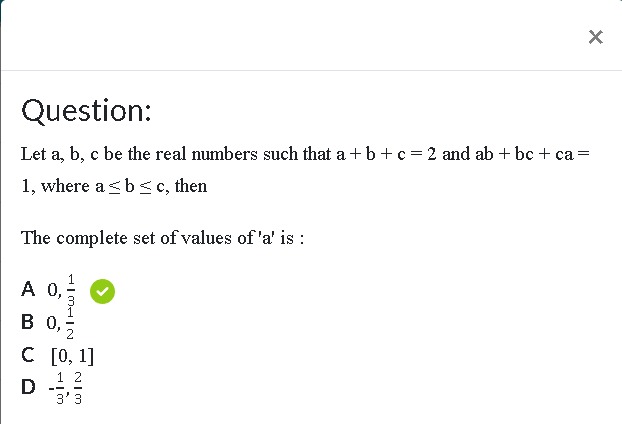Question
Question: Let a, b, c be the real numbers such that a + b + c = 2 and ab + bc + ca = 1, where a≤ b ≤ c, then ...
Let a, b, c be the real numbers such that a + b + c = 2 and ab + bc + ca = 1, where a≤ b ≤ c, then
The complete set of values of 'a' is :

0,31
0,21
[0, 1]
−31,32
The mathematically derived set of values for 'a' is [0, 1/3]. None of the provided options match this result. Option C is [0, 1]. Since [0, 1/3] ⊂ [0, 1], and intervals are expected for a "complete set of values", option C might be the intended answer, possibly due to a typo in the question or options. However, based on the rigorous derivation, values of 'a' in (1/3, 1] are not possible. Given the necessity to choose one option, and assuming a potential error in the options, option C is the most plausible candidate if the intended range was close to [0, 1] or [0, 1/3].
Solution
Let a, b, c be real numbers such that a + b + c = 2 and ab + bc + ca = 1, with the constraint a ≤ b ≤ c. Consider the quadratic equation whose roots are b and c. From the given equations, we have b + c = 2 - a and bc = 1 - a(b + c) = 1 - a(2 - a) = 1 - 2a + a² = (1 - a)². The quadratic equation is t2−(2−a)t+(1−a)2=0. For real roots b and c, the discriminant must be non-negative: Δ=(−(2−a))2−4(1−a)2=(2−a)2−4(1−a)2=(4−4a+a2)−4(1−2a+a2)=4−4a+a2−4+8a−4a2=4a−3a2. Δ≥0⟹4a−3a2≥0⟹a(4−3a)≥0. This inequality holds for 0≤a≤4/3.
The roots are b=2(2−a)−4a−3a2 and c=2(2−a)+4a−3a2. The condition a ≤ b ≤ c must be satisfied. The condition b ≤ c is satisfied if 4a−3a2≥0, which means 0≤a≤4/3.
The condition a ≤ b is: a≤2(2−a)−4a−3a2 2a≤2−a−4a−3a2 3a−2≤−4a−3a2 4a−3a2≤2−3a
For this inequality to hold, we need 2−3a≥0 (since the left side is non-negative) and 4a−3a2≥0 (for the square root to be real). 2−3a≥0⟹3a≤2⟹a≤2/3. 4a−3a2≥0⟹0≤a≤4/3. The intersection of these two conditions is 0≤a≤2/3.
If 0≤a≤2/3, we can square both sides of 4a−3a2≤2−3a: (4a−3a2)2≤(2−3a)2 4a−3a2≤4−12a+9a2 0≤12a2−16a+4 Divide by 4: 0≤3a2−4a+1 Factor the quadratic: 3a2−4a+1=(3a−1)(a−1). The inequality (3a−1)(a−1)≥0 holds when a≤1/3 or a≥1.
We need to satisfy all conditions for a ≤ b: 0≤a≤2/3 AND (a≤1/3 or a≥1). The intersection of [0,2/3] and (−∞,1/3]∪[1,∞) is [0,1/3]. So the condition a ≤ b holds for a∈[0,1/3].
For a ≤ b ≤ c to hold, we need a ≤ b AND b ≤ c, and b, c must be real. b, c are real when a∈[0,4/3]. a ≤ b holds when a∈[0,1/3]. b ≤ c holds when a∈[0,4/3].
The complete set of values of 'a' is the intersection of these conditions: [0,4/3]∩[0,1/3]∩[0,4/3]=[0,1/3].
The mathematically derived set of values for 'a' is [0,1/3]. Comparing this with the given options, none of the options exactly match this interval. Option C is [0,1]. Since [0,1/3]⊂[0,1], and intervals are expected for a "complete set of values", option C might be the intended answer, possibly due to a typo in the question or options. However, based on the rigorous derivation, values of 'a' in (1/3,1] are not possible.
Given the necessity to choose one option, and assuming a potential error in the options, option C is the most plausible candidate if the intended range was close to [0, 1] or [0, 1/3].
